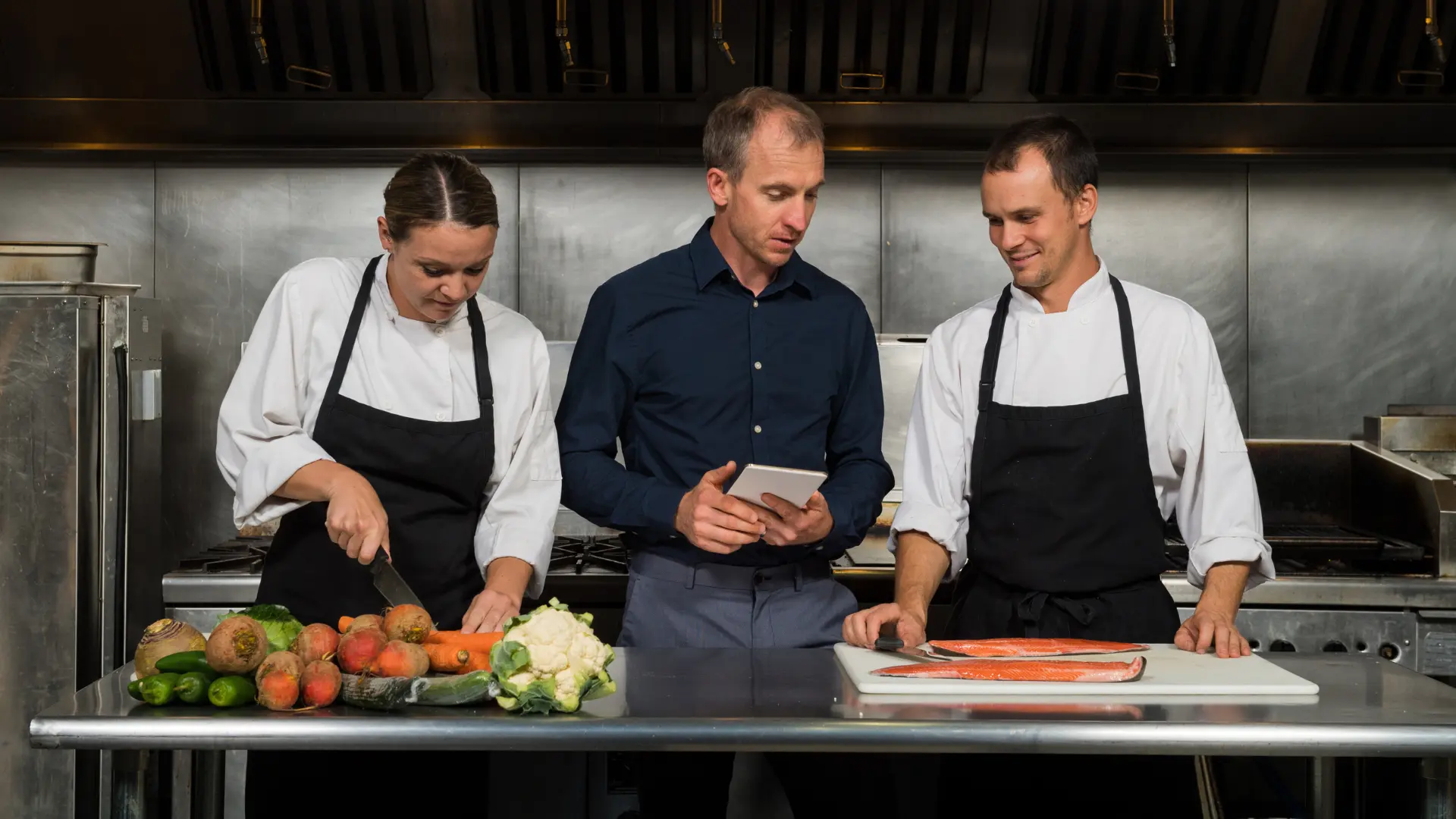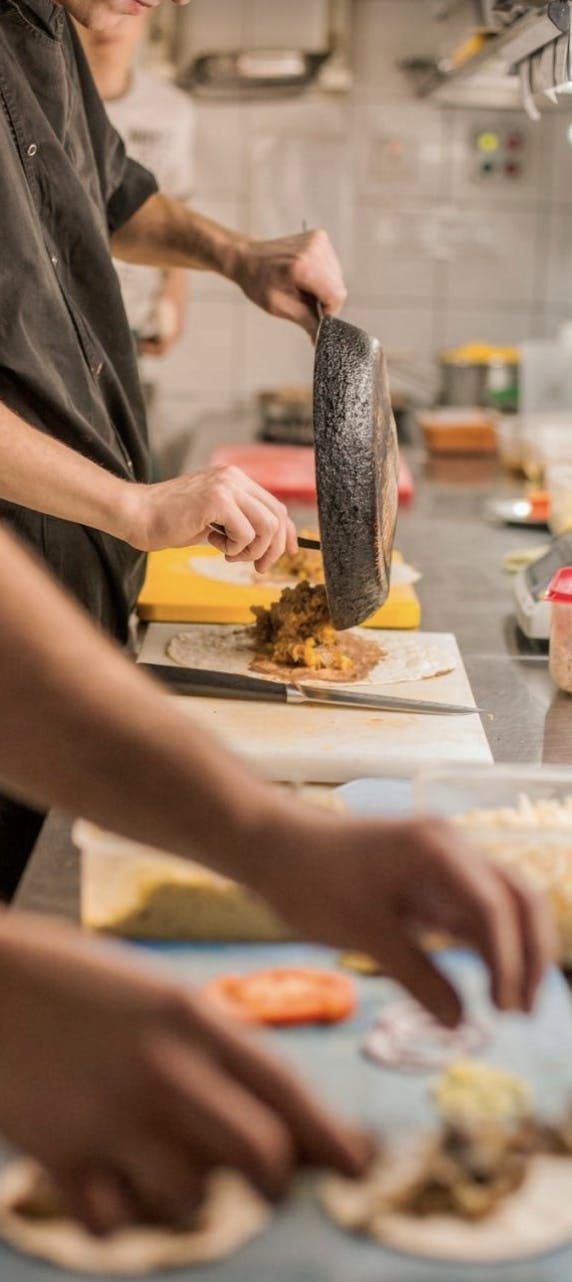How to grow & improve your catering sales
Table of Contents
CloudKitchens
How many tacos can be delivered from a 1000sqft restaurant?
The same amount as a 200sqft ghost kitchen.

Catering is a unique space. While large restaurant chains and major corporations may dominate the broader industry, catering offers opportunities for finding and thriving within a specific niche.
Data from a recent survey highlights this potential for success in the catering business. Only 5% of US caterers report annual sales below $250,000, while the majority (approximately 52%) achieve annual sales between $1 million and $7.5 million.
Clearly, growth is possible. The real challenge lies in keeping that momentum going. Learning how to grow catering sales—how to grow a catering business—often lies in mastering the fundamentals.
What sort of fundamentals, exactly? We’ve narrowed it down to 8 specific strategies.
#1. Hyperfocus on your niche
In the catering industry, profit margins tend to be more forgiving than those of brick-and-mortar restaurants. Still, it’s no secret that some events are more costly than others.
While it may be tempting to accept every potential client, being selective can significantly impact your profitability. Sometimes, it’s more beneficial to decline certain events and double down on those with higher profit margins.
Consider the revenue growth seen in different areas of catering through 2023:
- Full-service corporate events – 34%
- Weddings – 31%
- Miscellaneous events – 14%
- Corporate delivery and drop-off – 13%
- Galas and non-profits – 8%
These figures highlight where the greatest demand currently lies. Notably, corporate events saw significant growth, increasing from 25% of business in 2022 to the above-mentioned 34% in 2023.
Such trends indicate areas of rising demand—potentially spotlighting a lucrative niche for caterers to hone in on.
#2. Capitalize on customer interest
According to one survey, a critical aspect of catering business marketing strategy is to respond quickly to any inquiries, be that through email, social media, or phone calls. Staying agile and responsive can help you secure clients even as competition increases.
Equally important is tailoring your responses to each client’s specific needs. Read or listen carefully to their inquiries, and try to provide personalized replies rather than generic responses. Personalization makes clients feel genuinely valued, showing that you’re attentive to their unique requirements.
By adorning your speedy reply with a little personal flair, you lay the foundation for long-term relationships, transforming initial interest into sustained business.
#3. Craft a client-centric menu
In the catering business, your menu is more than just a list of dishes—it’s your primary sales tool and the heart of your brand. Crafting a menu that showcases your culinary skills and aligns with strategic business goals is crucial for attracting and retaining clients.
Here are a few ways you can maximize the effectiveness of your menu:
- Know your audience – Tailor the menu to your target market’s specific preferences and needs. Corporate events often crave easy-to-eat options, while weddings may wish to focus more on elaborate presentations and themed offerings.
- Emphasize versatility – A successful menu should be as diverse as your clientele. This can allow you to adapt and accommodate last-minute changes, dietary restrictions, or special requests.
- Highlight signature dishes – Showcasing a unique or specialty item can help you stand out from the competition. Such dishes could even become talking points that build your brand’s reputation.
While a menu primarily showcases your meal offerings, it’s also helpful to include information about the level of service you provide. For instance, specifying whether your catering involves simple food delivery or includes full-service options, from setup to cleanup, can help attract your ideal clients.
#4. Take a second look at your pricing
A simple way to boost the income from your catering sales is to raise prices. While this requires a delicate balance to remain competitive in the market, it’s at least advisable for caterers to regularly review pricing structure, especially in response to rising food costs.
For example, food prices increased nearly 6% in 2023 alone. If you haven’t adjusted menu prices to reflect that, your business might experience decreased profits. Routine cost analysis and market research can ensure your services remain competitive and in demand.
#5. Leverage social media marketing
Putting your catering business in front of an online audience is an effective way to attract new clients. Here are a few elements of a compelling social media marketing strategy:
- Regularly post high-quality images of your food and events, providing visually appealing content to showcase your offerings to potential clients.
- Offer a behind-the-scenes look into catering events, from preparation to execution, to humanize your brand and deepen your connection with your audience.
- Feature customer testimonials and positive feedback from satisfied clients to build trust and credibility.
Additionally, engage with your audience by responding to comments, answering questions, and participating in relevant online conversations. Utilizing social media platforms effectively from the very beginning can enhance your visibility—an important factor as you learn how to grow a catering business.
#6. Showcase a sample of your service
In addition to engaging digitally through social media, your catering business may benefit from more creative marketing. One example is investing in live demonstrations or tasting sessions, offering potential clients a firsthand experience of your food and service.
Implementing this strategy is relatively simple, involving just four steps:
- Research potential catering clients to invite. This could include local businesses if you focus on corporate catering, engaged couples if you’re a wedding caterer, or local non-profit organizations aligned with your niche.
- Reach out with the details. Take time to craft a captivating and original invitation to the event. The more personalized and original, the more likely it’ll capture the attention of your potential guests.
- Deliver a top-notch experience. By hosting the event yourself, you can play on your ‘home turf’ to maximize the tasting’s impact. Demonstrate the full range of your menu and services, explaining their nuances as you go.
- Be ready to follow up. Anticipate common questions about your catering services, and how clients should follow up if they’re interested in booking an event with you. Provide business cards or brochures for guests to take with them as they leave.
By offering a (literal) taste of your services, you provide a memorable experience that’s sure to leave a lasting impact on potential clients. To maximize the value of the event, consider hiring a photographer or taking high-quality pictures yourself for future promotional and marketing materials.
#7. Reward loyalty and referrals
Repeat customers are the lifeblood of any catering business, and new clients are the best way to grow. So, consider reaching both by implementing reward programs. This may take the form of:
- Point systems – Establish a system where customers earn points for every dollar spent, redeemable for discounts, free items, or unique service upgrades. Points encourage repeat business by providing a tangible reward for continued patronage.
- Tiered discounts – Offer discounts to incentivize repeat business. For example, you might bundle large-scale catering services into an upper-tier package to promote larger orders or offer a percentage discount for booking multiple events.
- Exclusive upgrades – Provide loyal customers with exclusive upgrades such as premium menu options, complimentary services, or priority booking for popular dates. Such perks add value to their experience and can enhance customer satisfaction.
Regardless of the reward system you choose, make sure it’s simple for both you and your customers to track and redeem rewards. Digital platforms and loyalty apps can streamline this process. You can also integrate these reward systems with a referral program, turning your existing clients into advocates for your business.
Implementing such loyalty and referral programs can help you retain current clients while attracting new ones, promoting a positive cycle of sustainable business growth.
#8. Just get started
Incorporating the strategies mentioned in this article may seem overwhelming at first, but taking actionable steps can make the process manageable and effective:
- Start reaching out and networking with individuals in related fields, like event planners and venue coordinators, to build connections that can lead to valuable referrals.
- Download any tools and software needed to help you kickstart a social media marketing campaign or incorporate a rewards program.
- Take time to review and refine your menu, promotional materials, and pricing strategy.
As you start to implement these strategies, you’ll gain momentum. Each step forward will make it easier to incorporate additional tactics, leading to genuine growth for your catering business. Don’t wait for the perfect moment—just get started, and watch your business flourish.
Maximize your catering sales with a ghost kitchen
The question of how to grow a catering business offers no easy answer. But with a commitment to quality and a sprinkle of strategy, success is sure to come.
Another approach that’s helped countless caterers achieve success? Opening a catering kitchen/ghost kitchen.
A ghost kitchen is a commercial kitchen space optimized for services like caterers who operate without a brick-and-mortar restaurant. By cutting out the overhead and enabling you to adapt quickly to market demands, ghost kitchens are the perfect way to break into catering services—or scale existing ones to match your success.
CloudKitchens offers a number of kitchens in catering hotspots across the US. We have locations all over the US, so if you need a commercial kitchen in Atlanta or a commercial kitchen in New Jersey, we’ve got you covered! We are ready to improve your efficiency to empower your food business journey. Talk to one of our experts or book a virtual tour, and see how we can help grow your catering sales today.
Explore ghost kitchen locations across the US:
- Ghost kitchens in Seattle
- Ghost kitchens in San Francisco
- Ghost kitchens in LA
- Ghost kitchens in NYC
- Ghost Kitchens in Toronto
- Ghost Kitchens in Atlanta
- Ghost Kitchens in Dallas
- Ghost Kitchens in Chicago
- Ghost Kitchens in Denver
- Ghost Kitchens in Miami
| DISCLAIMER: This information is provided for general informational purposes only and the content does not constitute an endorsement. CloudKitchens does not warrant the accuracy or completeness of any information, text, images/graphics, links, or other content contained within the blog content. We recommend that you consult with financial, legal, and business professionals for advice specific to your situation. |
Read more:
- What is a Commercial Kitchen?
- Essential Guide to Industrial Kitchen Equipment for Ghost Kitchens
- How much does it cost to rent a Commercial Kitchen?
- Top 5 commercial kitchen layout ideas to maximize efficiency
Sources:
Nuphoriq. Catering Industry Statistics. https://nuphoriq.com/catering-stats/
Harvard Business Review. Writing a Business Plan Makes Your Startup More Likely to Succeed. https://hbr.org/2017/07/research-writing-a-business-plan-makes-your-startup-more-likely-to-succeed
Starter Story. How Much Does It Cost To Start A Catering Business? (In 2024). https://www.starterstory.com/ideas/catering-business/startup-costs
Catering By Design. Everything You Need to Know About Catering. https://www.catering-by-design.com/blog/everything-you-need-to-know-about-catering/
More insights & stories
There’s more where that came from.
Get in the know and check out our additional insights


